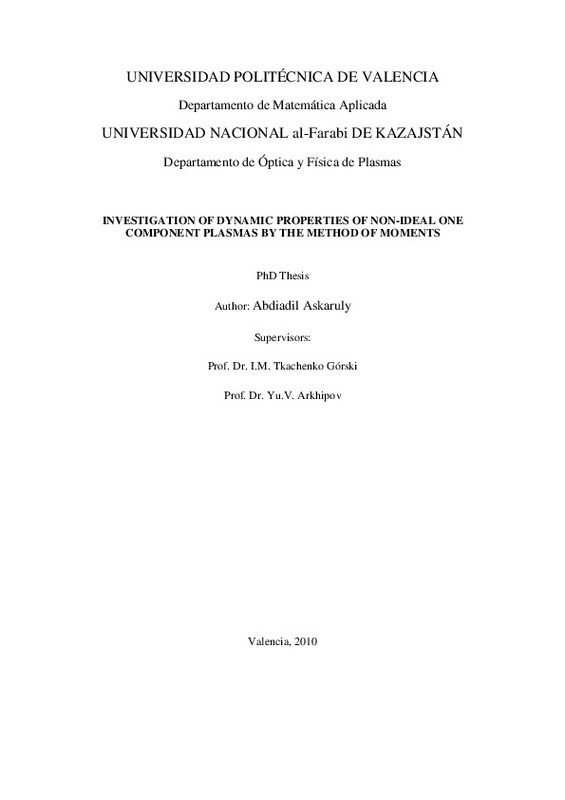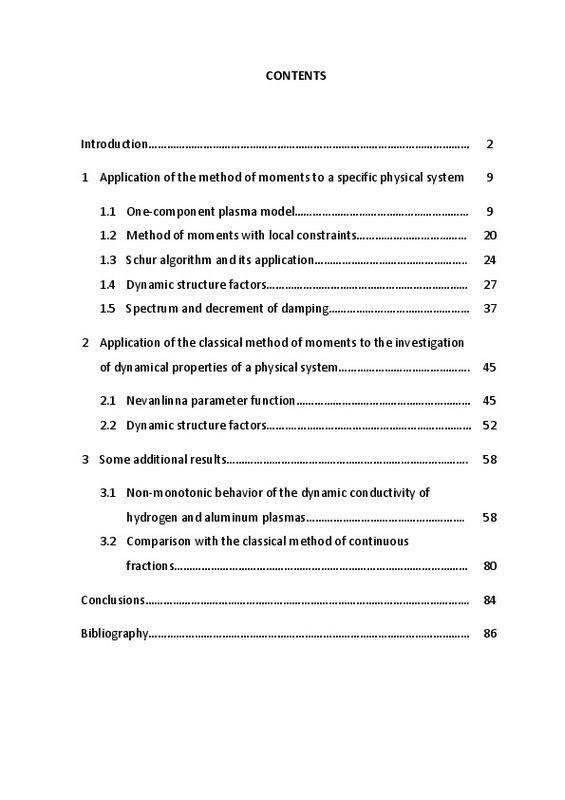- RiuNet repositorio UPV
- :
- Investigación
- :
- Tesis doctorales
- :
- Ver ítem
JavaScript is disabled for your browser. Some features of this site may not work without it.
Buscar en RiuNet
Listar
Mi cuenta
Estadísticas
Ayuda RiuNet
Admin. UPV
Investigation of dynamic properties of non-ideal one component plasmas by the method of moments
Mostrar el registro sencillo del ítem
Ficheros en el ítem
| dc.contributor.advisor | Tkachenko Gorski, Igor Mijail
|
es_ES |
| dc.contributor.advisor | Arkhipov, Yuriy
|
es_ES |
| dc.contributor.author | Askaruly, Abdiadil
|
es_ES |
| dc.date.accessioned | 2011-02-08T10:30:49Z | |
| dc.date.available | 2011-02-08T10:30:49Z | |
| dc.date.created | 2011-01-21T09:00:00Z | es_ES |
| dc.date.issued | 2011-02-08T10:30:46Z | es_ES |
| dc.identifier.uri | http://hdl.handle.net/10251/9474 | |
| dc.description.abstract | Investigation of dynamic properties of non-ideal one-component plasmas by the method of moments Dynamic characteristics of strongly coupled one-component plasmas are studied within the moment approach with local constraints by an algorithm similar to that of Schur. Some simulations of two-component plasmas are analyzed using sum rules and other exact relations. One of the main problems of plasma physics is to obtain an expression for the dielectric function determining screening effects, dispersion relations and other dynamic characteristics, such as conductivity, reflectivity, etc. The dielectric function can be derived from the linear-response theory, using the methods of the kinetic theory or hydrodynamics and by means of perturbation expansion of the Kubo formula. On the other hand, the dielectric function can be deduced on the basis of the method of moments. All methods mentioned above are mostly applicable in a limited range of variation of plasma parameters where some perturbation expansion can be used. There are no such restrictions on the plasma parameters in the method of moments which permit to reconstruct any Nevanlinna class function by its convergent power moments. In Physics these functions are called response functions which due to the causality principle satisfy the Kramers-Kronig relations, e.g., the plasma inverse dielectric function. Another dynamic characteristic, i.e. the dynamic structure factor which is related, via the fluctuation dissipation theorem, to the imaginary part of the inverse dielectric function, can be extracted from the experimental data. Thus, from both the practical and mathematical points of view, the study of the dynamic structure factor is important. There exist several approaches to the investigation of the dynamic structure factor. Beyond experimental and theoretical methods, some simulation techniques based on the first principles of mechanics and statistical physics, can be applied. | es_ES |
| dc.language | Inglés | es_ES |
| dc.publisher | Universitat Politècnica de València | es_ES |
| dc.rights | Reserva de todos los derechos | es_ES |
| dc.source | Riunet | |
| dc.subject | Método de momentos | es_ES |
| dc.subject | Plasmas fuertemente acoplados | es_ES |
| dc.subject.classification | MATEMATICA APLICADA | es_ES |
| dc.title | Investigation of dynamic properties of non-ideal one component plasmas by the method of moments | |
| dc.type | Tesis doctoral | es_ES |
| dc.subject.unesco | 120209 - Funciones de una variable compleja | es_ES |
| dc.subject.unesco | 220410 - Física de plasmas | es_ES |
| dc.subject.unesco | 221303 - Altas presiones | es_ES |
| dc.subject.unesco | 2209 - Óptica | es_ES |
| dc.identifier.doi | 10.4995/Thesis/10251/9474 | es_ES |
| dc.rights.accessRights | Abierto | es_ES |
| dc.contributor.affiliation | Universitat Politècnica de València. Departamento de Matemática Aplicada - Departament de Matemàtica Aplicada | es_ES |
| dc.description.bibliographicCitation | Askaruly, A. (2011). Investigation of dynamic properties of non-ideal one component plasmas by the method of moments [Tesis doctoral no publicada]. Universitat Politècnica de València. https://doi.org/10.4995/Thesis/10251/9474 | es_ES |
| dc.description.accrualMethod | Palancia | es_ES |
| dc.type.version | info:eu-repo/semantics/acceptedVersion | es_ES |
| dc.relation.tesis | 3465 | es_ES |
Este ítem aparece en la(s) siguiente(s) colección(ones)
-
Tesis doctorales [5346]







![Text file [Text]](/themes/UPV/images/text.png)


